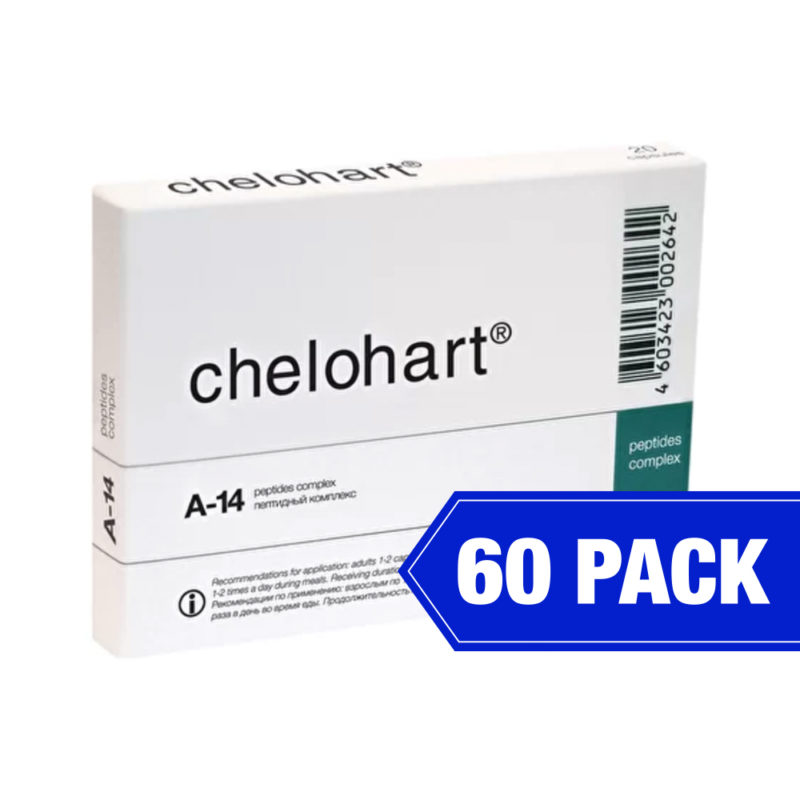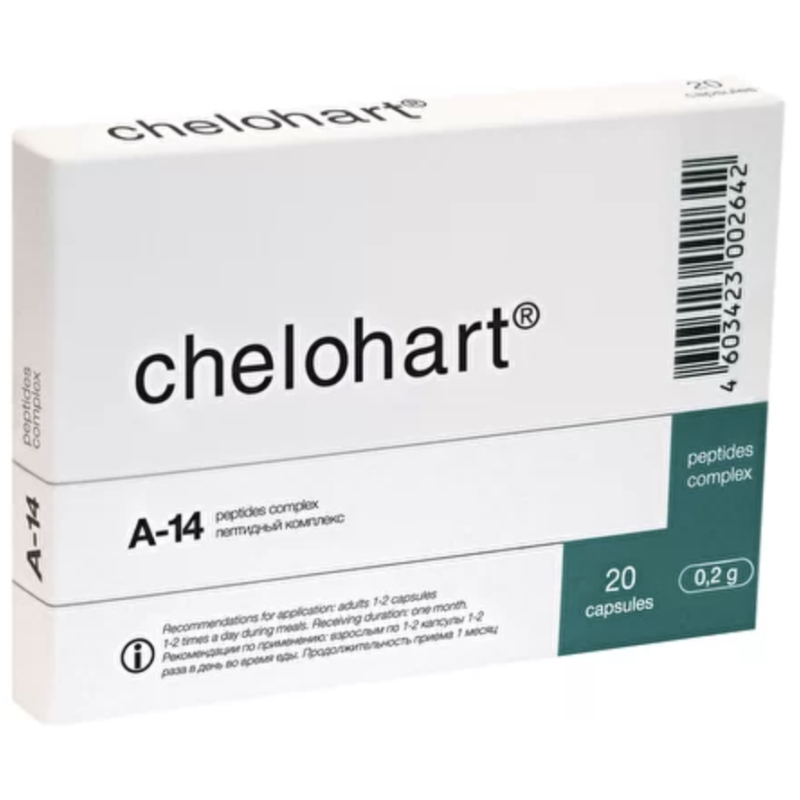REPORT on the results of clinical study of peptide bioregulator Chelohart
REPORT of clinical study of the Biologically Active Food Supplement Chelohart®
Biologically active food supplement Chelohart® contains a complex of low-molecular peptides with a molecular weight of up to 5000 Da, isolated from the heart tissue of young animals – calves not older than 12 months of age or pigs.
Chelohart® is available in the form of capsules with the active substance content of 10 mg.
Experimental studies have shown that peptides have tissue-specific action on the cells of the tissues, which they were isolated from. Chelohart® regulates metabolic processes in myocardial cells, increases the reserve capacity of myocardiocytes by causing a beneficial effect on the adaptation processes of the body in extreme conditions, possesses antioxidant properties and regulates the processes of peroxidation in the myocardium. This allows us to assume the effectiveness of Chelohart® for the restoration of heart functions in case of violations of various origins.
Violation of myocardial metabolism associated with oxygen deficiency underlies the development of various forms of ischemic heart disease, is a common link in the pathogenesis of cardiomyopathies, and is the cause of various cardiac disorders. The pathological process is based on violation of the correspondence between the heart’s need for blood supply and the functioning of the vascular system. Impaired blood supply to the myocardium is most often caused by atherosclerosis of the coronary vessels, which is one of the most common age-related pathologies (1). Of particular concern to clinicians in recent decades is the emergence of this age-related pathology in people of younger age, which leads to the “rejuvenation” of myocardial infarction and an increased risk of developing its complications.
Ischemic heart disease is one of the most common causes of not only disqualification and disability of patients, but also mortality among the population of developed countries.
Conservative treatment of patients with ischemic heart disease, taking into account pathogenetic mechanisms, the following traditional therapeutic agents of various directions of action are mainly used (1, 2):
– vasodilators (nitroglycerin, nitrong, erinit);
– calcium antagonists (verapamil, fenigidin);
– β-blockers (anaprilin, trazicor);
– drugs that weaken adrenergic effects on the heart (cordaron);
– etc.
Clinical characteristics of patients
A clinical study on the effectiveness of the use of Chelohart® was carried out at the Medical Center of the St. Petersburg Institute of Bioregulation and Gerontology from May to November 2011.
The clinical study involved 32 patients with ischemic heart disease – exertional angina of the 1st and 2nd functional class – aged from 46 to 72 years, including 18 men and 14 women. Disease duration ranged from 2 to 9 years. Patients complained of rapid fatigue, decreased performance, weakness, tinnitus, dizziness, a feeling of rapid heartbeat, shortness of breath, recurrent pain in the heart, limited physical activity, the onset of chest pain attacks with a characteristic irradiation to the left shoulder, left arm, interscapular space. 19 patients (59.4%) diagnosed with exertional angina pectoris of the 1st class noted the development of seizures only with great physical exertion; the attacks were quickly stopped after the use of nitroglycerin. In 10 patients (31.2%) diagnosed with exertional angina pectoris of the 2nd class, attacks of pain behind the sternum occurred when walking a distance of more than 500 m, when climbing stairs. At the same time, the patients noted a gradual increase in the frequency of attacks, which required an increase in the dose of nitro drugs.
An objective examination in 26 patients (81.2%) on an electrocardiogram revealed signs of impaired coronary circulation during stress tests: a decrease in the S-T segment, a smoothed or negative T wave in the standard and corresponding chest leads.
Analysis of the results of general clinical and biochemical blood tests did not reveal significant deviations from normal values in each age group.
The patients were divided into 2 groups. The main group included 22 patients, including 14 men aged from 46 to 64 years old and 8 women aged from 51 to 72 years old, who, in addition to the conventional methods of treatment, were prescribed a course of Chelohart® by 1 capsule 2 times a day during meal time for 30 days.
The control group consisted of 10 patients (6 men aged 47 to 66 years old and 4 women aged 50 to 69 years old), who were prescribed only conventional treatment: long-acting nitrates, β-blockers, corinfar, corvalol, motherwort tincture and others sedatives (2, 3).
Research methods
The study of the effectiveness of Chelohart® use was carried out on the basis of generally accepted research methods. Patients’ complaints were assessed in dynamics, general clinical and biochemical blood tests, ultrasound examination of the heart, electrocardiography, a dosed exercise test on a bicycle ergometer were carried out according to the method of stepwise increasing intermittent load.
Research results
Research results on the dynamics of changes in subjective indicators showed that patients administered with Chelohart® manifested a decreased number of complaints about the general condition, dyspnea, periodic pain in the hear and a feeling of rapid heartbeat. The frequency and duration of angina attacks significantly decreased. 56 % of patients managed to halve the daily dose of long-acting nitrates against the background of a persistent decrease in the attacks of chest pain compared to the initial level before treatment (Tab. 1).
Table 1
Dynamics of subjective indicators in patients with ischemic heart disease
|
Complaints |
Group of patients |
|||
|
After conventional therapy, abs. (%) |
After therapy with the addition of Chelohart®, abs. (%) |
|||
|
Improvement
|
No improvement |
Improvement
|
No improvement |
|
|
Recurrent pain in the heart area |
4 (40%) |
6 (60%) |
15 (68,2%)* |
7 (31,8%)* |
|
Dyspnea |
6 (60%) |
4 (40%) |
16 (72,7%)* |
6 (27,3%)* |
|
Asthenia |
7 (70%) |
3 (30%) |
16 (72,7%)* |
6 (27,3%)* |
|
Dizziness |
6 (60%) |
4 (40%) |
12 (54,5%) |
10 (45,5%) |
|
Headache |
5 (50%) |
5 (50%) |
15 (68,2%)* |
7 (31,8%)* |
|
Noise in ears |
5 (50%) |
5 (50%) |
14 (63,6%) |
8 (36,4%) |
|
Feeling of heartbeat |
6 (60%) |
4 (40%) |
17 (77,3%)* |
5 (22,7%)* |
* р<0,05 compared with the indicator in patients after conventional therapy.
The study of the dynamics of changes in mineral metabolism showed that in patients of both groups, the content of potassium in the blood plasma and calcium in the blood serum increased, approaching normal values. There was no significant difference in the indicators in patients of the main and control groups, although the patients of the main group administered with Chelohart®, showed better indicators after treatment than the control group. The content of magnesium in blood serum remained within the normal range both before and after treatment in patients of both groups. (Tab. 2).
Table 2
Dynamics of changes in the parameters of mineral metabolism in the blood
of patients with ischemic heart disease
|
Parameter |
Reference range |
Conventional therapy |
Therapy with the addition of Chelohart® |
||
|
Before treatment |
After treatment |
Before treatment |
After treatment |
||
|
Potassium, mmol / l |
3,4-5,3 |
3,13±0,6 |
3,48±0,4 |
3,10±0,4 |
3,52±0,5 |
|
Calcium, mmol / l |
2,3-2,75 |
2,22±0,03 |
2,36±0,06 |
2,23±0,05 |
2,41±0,06 |
|
Magnesium, mmol / l |
0,7-1,2 |
0,83±0,04 |
0,88±0,06 |
0,84±0,07 |
0,90±0,05 |
According to veloergometry data, provoking an attack of angina pectoris at the maximal load after using Chelohart® was observed reliably 1.9 times less than before treatment, while in patients of the control group – only 1.4 times (Table 3). After complex treatment with Chelohart® 54.5% of patients achieved a submaximal heart rate (HR) at the maximal load threshold, while in the control group – only 40% (before treatment – 21.9% of patients in both groups).
The assessment of tolerance was carried out according to the value of the threshold power and the total volume of work performed. Tolerance to physical activity, as an indicator of positive antianginal treatment, was significantly higher in patients of the main group after taking Chelohart® compared with the indicators before treatment, although the difference with the indicators in patients in the control group was insignificant.
To assess the efficiency of the cardiovascular system, the energy expenditure index was calculated. A 1.6-fold decrease in the index after using Chelohart® testified to a more economical expenditure of energy reserves of the heart due to a decrease in myocardial oxygen demand during work performance (in patients of the control group – 1.3 times), which was reflected in a significant increase in the index of maximum oxygen consumption by 16% in patients of the main group (in the control group – by 11%) compared with the indicator before treatment.
Table 3
Dynamics of cycle ergometry indices in patients with ischemic heart disease
|
Parameter |
Before treatment
|
After conventional therapy |
After therapy with the addition of Chelohart® |
|
The frequency of angina attacks, % |
68,8 |
50* |
36,4*# |
Reaching submaximal heart rate, % |
21,9 |
40* |
54,5 *# |
|
Cycle ergometry threshold power, W / min |
96,9±4,6 |
115,2±5,4 |
119,3±4,6*
|
Total, kgm |
2830±118 |
3457±110* |
3673±119* |
Energy cost index, units |
15,8±1,4 |
11,9±2,4* |
9,6±2,1* |
Index of maximum oxygen consumption, units |
1,3±0,03 |
1,44±0,05* |
1,49±0,04* |
* р<0,05 in comparison with the indicator in patients before treatment;
# р<0,05 in comparison with the indicator in patients before conventional treatment.
Thus, as a result of the study, it was established that Chelohart® has a pronounced effect on the contractile function of the myocardium in patients with ischemic heart disease. An increase in the tolerance of patients to stress tests indicates an anti-ischemic effect of the drug, and an improvement in mineral metabolism indicators proves its positive effect on metabolic processes in myocardial cells. In addition, a significant decrease in the energy consumption index was shown due to an increase in the maximum oxygen consumption index.
When conducting a clinical study on Chelohart® in elderly people, no side effects, complications, or drug dependence were revealed. Contraindication for the use of the drug is an individual intolerance to its components.
Thus, the results of the study indicate the advisability of Chelohart® addition to the complex treatment of patients with angina pectoris of the 1-2 functional class, as well as its administration for the prevention of age-related pathology of the cardiovascular system. Chelohart® should be taken in courses of 1-2 capsules 2 times per day for 30 days, repeating them 2-3 times a year.
References
- Korkushko О.V. Age-related changes in the autonomic regulation of the heart rate in healthy elderly and old people / O.V. Korkushko, V.B. Shatilo, G.M. Butenko // Physiol. magazine – 1988. – Issue 34, № 1. – P. 12-17.
- Mashkovsky M.D. Medicines: Pharmacotherapy manual for healthcare professionals: 2 parts – Vilnus: ZAO “Gamta”, 1993.
- Metelitsa V.I. Cardiologist’s Guide to Clinical Pharmacology. – М.: Medicine, 1980. – 304 pages.
Recommendations for use
Chelohart® is a complex of peptides obtained from the heart of young animals. The isolated peptides have a selective effect on myocardial cells, normalize metabolism in myocardiocytes and regulate heart functions.
Clinical study revealed the effectiveness of Chelohart® in the complex treatment of patients with cardiovascular pathology, including ischemic heart disease. Chelohart® restored myocardial functions after diseases of various origins, after exposure to extreme environmental factors, malnutrition and ageing.
Chelohart® should be taken per os at mealtime 1-2 capsules 1-2 times a day. The period of administration makes 30 days. It is advisable to have a repeated course in 4-6 month.
Contraindications: individual intolerance to the components, pregnancy, breast feeding.
Administration of Chelohart® has not resulted in any side effects.
It is recommended to store in a dry dark place at the temperature from +2 up to +25ºС.
Pharmaceutical form: 20 capsules or tablets of Chelohart® 10 mg each.
Period of validity – 3 years from the day of manufacturing.
Executive officer:
|
Deputy Director of LLC “Medical Center of Saint Petersburg Institute of Bioregulation and Gerontology of the Northwest Branch of the Russian Academy of Medical Sciences” in charge of clinical affairs, Ph.D., assistant professor |
______________________A.A. Veretenko |
|
Action officer: Chief Physician of LLC “Medical Center of Saint Petersburg Institute of Bioregulation and Gerontology of the Northwest Branch of the Russian Academy of Medical Sciences”, Ph.D. |
_____________________O.Y. Raygorodsky |


